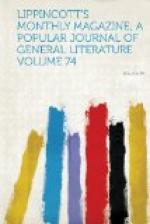Thus entrenched in a well-provisioned citadel, welcoming all the new levies it can win, and amply able to provide for them, Mormonism bids fair to make a prolonged stand. To emerge from a defensive position and strike for unlimited sway is what it cannot, to judge by all precedents, expect. It will be compelled, in fact, to lighten itself of some dead weights in order to maintain its actual situation. Polygamy must go, and the absolute power of the priesthood be modified. With some such adaptations it may continue a reality for generations to come. And time is a great sanctifier. A creed that lives for one or two centuries is by so much the more likely to live longer. Youth is the critical period with religions, as with animals and plants and nations. Through that period Mormonism is passing with flattering success. That such a lusty juvenile will, by favor of the mellowing effect imposed on all creeds by early years of toil, trouble and experience, reach a middle age of presentable decency, is not a more unlikely supposition than the worthy Vermont clergyman would have pronounced, half a century ago, the idea that his jeu d’esprit would become the Bible of sixty thousand industrious, well-ordered English-speaking people in the heart of the American continent.
E.C.B.
THE EDUCATION OF WOMEN IN INDIA.
According to a report sent to our Commissioner of Education at Washington four years ago, there were then in India one thousand girls’ schools supported by the government and some five hundred missionary schools devoted to female education. Besides these, there has sprung up during the last few years a new field for the women-educators in that country. This is the teaching of women in their homes. It is called zenana-work. The zenana is the women’s apartment in the house—the harem of the Turks. Women have been sent from England and from America for this special object, and their labors are meeting with encouraging success. They are constantly gaining admission to new families, which from caste or other causes are opposed to sending their young women to the regular schools. Some of the zenana-teachers are regularly-educated physicians.
For the government schools each province has a director of public instruction, with inspectors of divisions and subdivisions. These directors are “gentlemen of high qualification and well paid.” It is a notable fact that in one of the provinces the office of director is filled by a Christian woman—a foreigner no doubt, though the report does not say.
At Dehra, at the foot of the Himalaya Mountains, there is a high school for girls organized on the plan of the Mount Holyoke Seminary. Here English is spoken, and the pupils are carried through a course of training that may justly be termed high. One of the pupils of this school has lately been appointed by the government to go to England and qualify herself as a physician, under a contract to return and serve the government by taking charge of a hospital and college for training young women as midwives and nurses.




